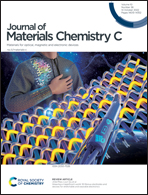Room temperature light induced spin state switching in a FeII coordination polymer featuring a photo responsive anion†‡
Abstract
The FeII coordination polymer, [Fe(NH2trz)3](psca)2·2H2O (CP-1), incorporating a photo-responsive non-coordinated anion, p-sulfocinnamic acid (psca), was synthesized in the pursuit of solid state light-induced spin crossover at room temperature. 57Fe Mössbauer spectroscopy shows that CP-1 exists in a mixed spin state with a major low-spin fraction at room temperature. UV irradiation on CP-1 caused a colour change from pink to brown and yielded the photoproduct, [Fe(NH2trz)3](dsta)·2.5H2O (CP-2) at room temperature. Diffuse reflectance spectroscopy suggested successful photodimerization of psca after irradiation and also indicated a change in spin states as an irradiation effect. This is supported by SQUID magnetometry and 57Fe Mössbauer spectroscopy measurements of CP-2, which confirmed an increase in the high-spin fraction from 29% to 53% at room temperature, as an effect of UV irradiation. Such Anion Driven Light Induced Spin State Change (AD-LISC), which is observed for the first time, leads to a modification of the spin crossover properties from CP-1 to CP-2. A spin crossover material embedding a non photo-switching anion, [Fe(NH2trz)3](tos)2·H2O was studied too, to support the photo-irradiation effect, on CP-1.



 Please wait while we load your content...
Please wait while we load your content...